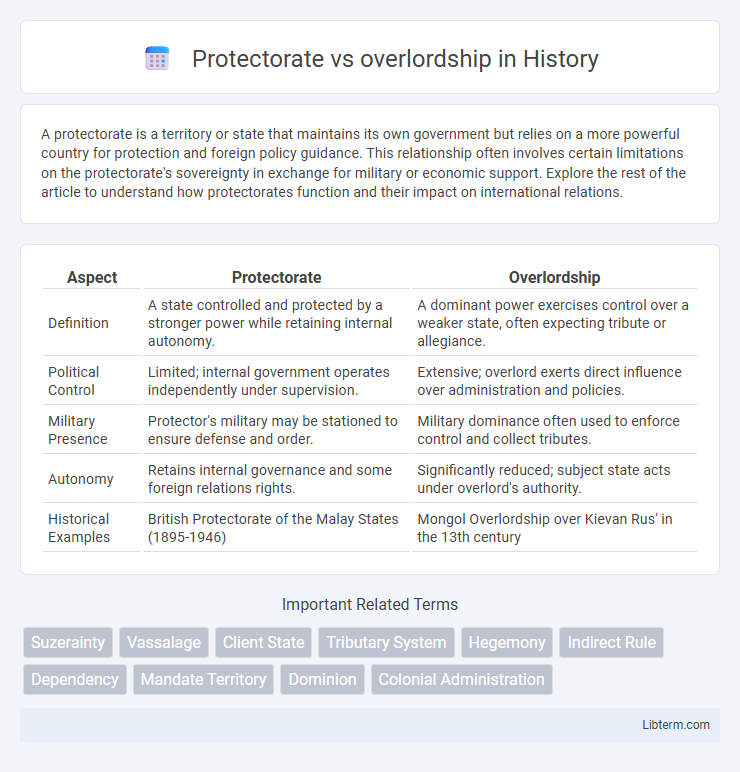A protectorate is a territory or state that maintains its own government but relies on a more powerful country for protection and foreign policy guidance. This relationship often involves certain limitations on the protectorate's sovereignty in exchange for military or economic support. Explore the rest of the article to understand how protectorates function and their impact on international relations.
Table of Comparison
| Aspect | Protectorate | Overlordship |
|---|---|---|
| Definition | A state controlled and protected by a stronger power while retaining internal autonomy. | A dominant power exercises control over a weaker state, often expecting tribute or allegiance. |
| Political Control | Limited; internal government operates independently under supervision. | Extensive; overlord exerts direct influence over administration and policies. |
| Military Presence | Protector's military may be stationed to ensure defense and order. | Military dominance often used to enforce control and collect tributes. |
| Autonomy | Retains internal governance and some foreign relations rights. | Significantly reduced; subject state acts under overlord's authority. |
| Historical Examples | British Protectorate of the Malay States (1895-1946) | Mongol Overlordship over Kievan Rus' in the 13th century |
Understanding Protectorate and Overlordship
Protectorate refers to a political arrangement where a powerful state assumes control over the foreign policy and defense of a weaker territory while allowing internal autonomy. Overlordship denotes a relationship where an overlord exercises supreme authority over subordinate states or territories, often demanding tribute and obedience. Understanding the distinction lies in recognizing that protectorates maintain some degree of self-governance under supervision, whereas overlordship implies more direct dominance and control.
Historical Origins of Protectorates and Overlordships
Protectorates originated during the colonial era as territories granted limited self-rule under the protection and control of a more powerful state, often formalized through treaties emphasizing defense and external affairs. Overlordship, rooted in feudal systems and medieval governance, involved a superior sovereign exerting authority over subordinate rulers, demanding loyalty and tribute without direct administrative control. The historical development of protectorates reflects modern imperial policies, whereas overlordship derives from decentralized power structures in pre-modern societies.
Key Differences Between Protectorate and Overlordship
Protectorate status involves a weaker state retaining internal autonomy while another state controls its foreign affairs and defense, emphasizing a formal treaty-based relationship. Overlordship denotes a dominant state's control over a subordinate state's internal and external matters, often exercised through direct political or military authority without formal agreement. Key differences include the degree of sovereignty retained, the nature of control--diplomatic versus political--and the legal framework governing the relationship.
Examples of Protectorate Systems in History
Protectorate systems historically include the British protectorates over the Niger Coast (1891-1900) and Egypt (1882-1956), where local rulers retained nominal authority while Britain controlled foreign affairs and defense. The Congo Free State under King Leopold II functioned as a unique protectorate with direct exploitation disguised as protection. Protectorates differ from overlordship by maintaining indigenous governance structures under the supervision of a foreign power rather than complete political domination.
Notable Cases of Overlordship in Practice
Notable cases of overlordship in practice include the feudal system of medieval Europe, where powerful lords exercised control over vassals through military allegiance and land tenure, exemplified by the English Crown's dominance over its barons. The Mughal Empire's suzerainty over various Indian princely states showcased overlordship through tribute and nominal allegiance, allowing local rulers internal autonomy. Similarly, the Ottoman Empire exerted overlordship by recognizing local leaders' authority in exchange for loyalty and tax payments, maintaining a vast and diverse dominion.
Legal and Political Structures Compared
Protectorate status involves a formal agreement where the protectorate retains internal autonomy while the protector state controls external affairs and defense, establishing clear legal distinctions and limited political integration. Overlordship implies a more dominant power exerting control over political decisions, often integrating governance structures and diminishing the overlorded state's sovereignty without formal treaties. Legal frameworks in protectorates emphasize mutual recognition and defined obligations, whereas overlordship often features unilateral authority and dominance over political institutions.
Impact on Sovereignty and Autonomy
Protectorate status typically allows the local government to retain nominal sovereignty while ceding control over foreign affairs and defense to the protecting power, resulting in limited autonomy. Overlordship often implies a more direct and dominant control where the overlord exercises significant authority over internal governance, substantially reducing the sovereignty of the subordinate state. The impact on sovereignty under protectorate arrangements tends to be less intrusive compared to overlordship, which frequently leads to near-total loss of autonomous decision-making.
Diplomatic Relations Under Each System
Diplomatic relations under protectorate status often involve the protected state maintaining nominal sovereignty while its foreign affairs and defense are controlled by the protecting power, ensuring limited autonomy in international dealings. Overlordship typically denotes a more direct and dominant control, where the overlord exerts substantial influence over the vassal state's internal and external policies, reducing diplomatic independence significantly. These distinctions affect alliance formation, treaty negotiations, and the degree of participation in global institutions by the subordinate entity.
Economic Consequences of Protectorate vs Overlordship
Protectorate arrangements often allow local economies to retain a degree of autonomy, facilitating trade partnerships under the protection of a stronger state, which can lead to more sustainable economic development. Overlordship typically imposes direct control over resources and economic policies, redistributing wealth to the dominant power and causing economic dependency or exploitation of the subordinate region. These contrasting governance models directly influence trade dynamics, resource management, and long-term economic growth patterns in the affected territories.
Modern Relevance and Legacy
Protectorate arrangements remain relevant in modern geopolitics as they often involve a powerful state providing defense and foreign policy oversight to a weaker state, preserving sovereignty while ensuring strategic alliances. Overlordship, characterized by direct control or dominance, has largely diminished in contemporary international relations but continues to influence post-colonial power dynamics and territorial disputes. The legacy of both systems shapes current debates on sovereignty, neo-colonialism, and international law regarding state autonomy and intervention.
Protectorate Infographic

 libterm.com
libterm.com